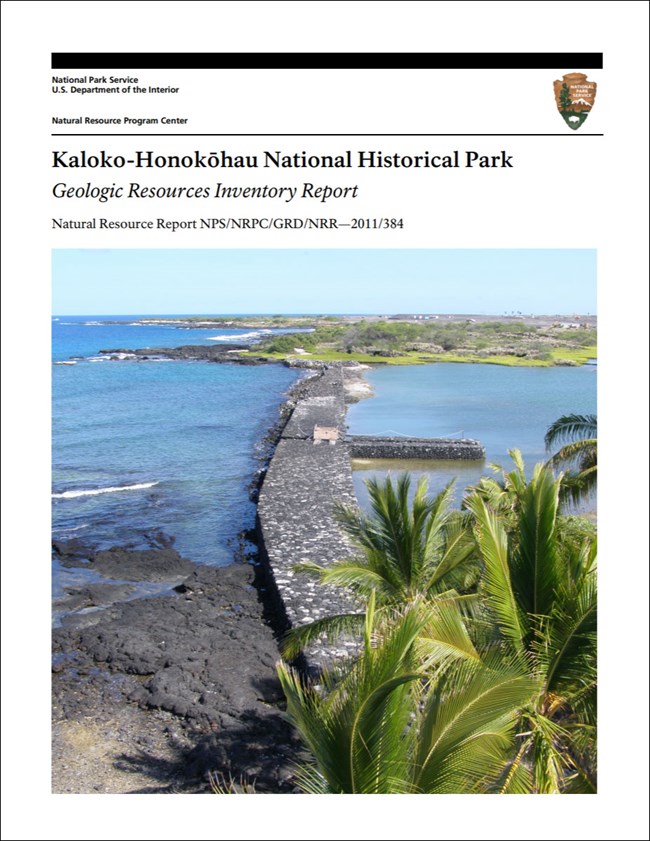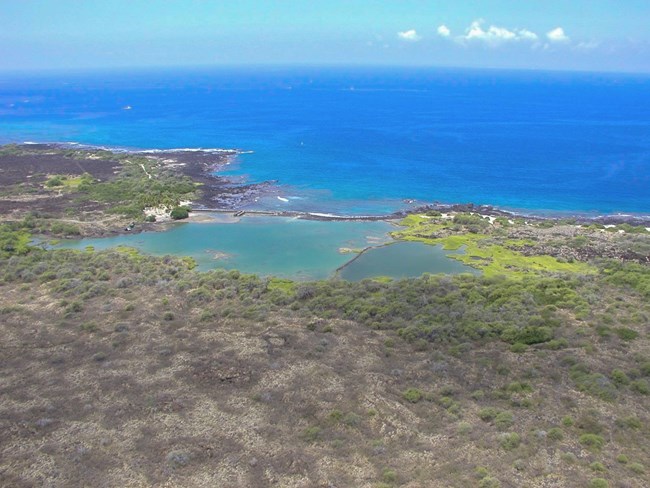Last updated: July 9, 2024
Article
NPS Geodiversity Atlas—Kaloko-Honokohau National Historical Park, Hawaii
Geodiversity refers to the full variety of natural geologic (rocks, minerals, sediments, fossils, landforms, and physical processes) and soil resources and processes that occur in the park. A product of the Geologic Resources Inventory, the NPS Geodiversity Atlas delivers information in support of education, Geoconservation, and integrated management of living (biotic) and non-living (abiotic) components of the ecosystem.

Introduction
Kaloko-Honokōhau National Historical Park (KAHO) is located on the west coast of the island of Hawai‘i, approximately 4.8 km (3 mi) south of the Keahole International Airport and 4.8 km (3 mi) north of the town of Kailua-Kona. Established on November 10, 1978, KAHO encompasses about 470 hectares (1,163 acres) and once sustained early Hawaiian settlements prior to the arrival of Europeans. The historical park was established for the preservation, interpretation, and practice of traditional Native Hawaiian activities and culture. KAHO contains coastal areas, archaeological remnants, and three fishponds that illustrate ingenious engineering, aquaculture techniques, and practices of the past that offer opportunities for Hawaiian aquaculture to thrive into the future.
Geologic Setting
Located on the western slope of Hualālai Volcano, the geology of Kaloko-Honokōhau National Historical Park is dominated by volcanic flows of the Hualālai volcanic center. The Holocene-age basaltic flows at KAHO can be subdivided into three distinct eruptive episodes: 1) approximately 3,000–1,500 years old; 2) 5,000– 3,000 years old; and 3) 10,000–5,000 years old (Wolfe and Morris 1996). These lava flows generally have an undissected (free of erosion channels) surface and represent older pāhoehoe lavas characterized by a smooth, “ropey” texture that were later covered in part by ‘a‘ā lavas that have a rough, jagged texture (Wolfe and Morris 1996). The landscape of KAHO consists of stark, rugged basalt flows that form broad benches or terraces along the shore, with sparse carbonate sand and gravel beach areas that include intertidal and supratidal accumulations of perched storm sediments (Thornberry-Ehrlich 2011b).
- Scoping summaries are records of scoping meetings where NPS staff and local geologists determined the park’s geologic mapping plan and what content should be included in the report.
- Digital geologic maps include files for viewing in GIS software, a guide to using the data, and a document with ancillary map information. Newer products also include data viewable in Google Earth and online map services.
- Reports use the maps to discuss the park’s setting and significance, notable geologic features and processes, geologic resource management issues, and geologic history.
- Posters are a static view of the GIS data in PDF format. Newer posters include aerial imagery or shaded relief and other park information. They are also included with the reports.
- Projects list basic information about the program and all products available for a park.
Source: NPS DataStore Saved Search 2914. To search for additional information, visit the NPS DataStore.
A NPS Soil Resources Inventory project has been completed for Kaloko-Honokohau National Historical Park and can be found on the NPS Data Store.
Source: NPS DataStore Saved Search 2986. To search for additional information, visit the NPS DataStore.

Related Links
Related Articles
Kaloko-Honokohau National Historical Park
National Park Service Geodiversity Atlas
The servicewide Geodiversity Atlas provides information on geoheritage and geodiversity resources and values within the National Park System. This information supports science-based geoconservation and interpretation in the NPS, as well as STEM education in schools, museums, and field camps. The NPS Geologic Resources Division and many parks work with National and International geoconservation communities to ensure that NPS abiotic resources are managed using the highest standards and best practices available.

